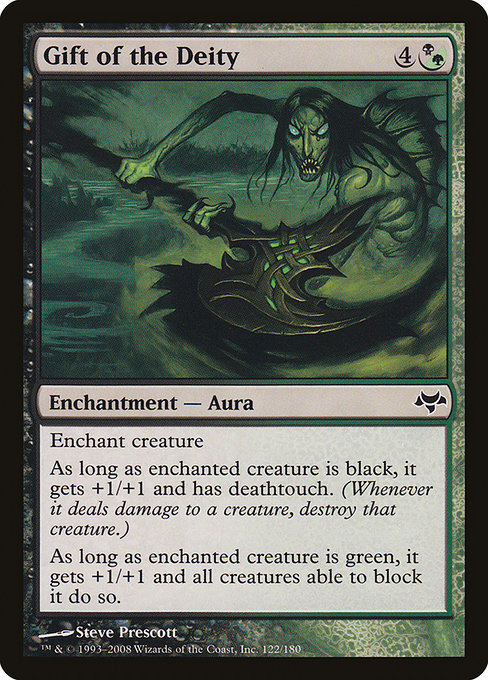
Image courtesy of Scryfall.com
Design Chaos and the Subtleties of Human Behavior in MTG
Magic: The Gathering isn’t just about immediate power on the battlefield; it’s a living experiment in how players think, adapt, and improvise under evolving rules and ambiguous information. The Eventide era—when hybrid mana and color-mued mechanics found new voice—gave us a small but punchy example of design chaos embodied in a single aura. The card’s two-color identity and its conditional text invite players to consider not only what to play, but when to play it and whom to outwit across the board. 🧙🔥 The experience echoes the way human beings navigate gray areas in real life: we lean on flexible options, adjust to what our opponents reveal, and find clever leverage where structure feels fluid.
Hybrid mana as a social contract
The mana cost—{4}{B/G}—isn’t just a math line; it’s a statement about flexibility. Hybrid costs invite a broader spectrum of mana sources, letting players swing between black and green roots without forcing a rigid two-color plan. This design choice lowers the barrier to experimentation and encourages players to consider hybrid decks, nimble splashes, and unexpected pairings. In practice, it rewards players who think in terms of risk management and resource allocation—traits common to how people approach uncertain situations in life and work. The result is a design space that feels both familiar and opportunistic, a microcosm of how communities improvise in the face of constraints. 💎
The two faces of a single aura
Enchant creature is a classic mechanic that anchors a spell to the battlefield. Here, the aura’s power shifts with the color of its target. If the enchanted creature is black, it becomes a +1/+1 creature with deathtouch. Deathtouch is a design lever that makes every damage-delivery moment feel weightier—one tiny strike can wipe out a more robust threat, which adds a tense, two-way chess vibe to combat. If the enchanted creature is green, it still gets +1/+1, but the other effect kicks in: all creatures capable of blocking it must do so. That creates a dramatic force-multiplier in combat, turning a single aura into a strategic pressure point that can bend the table’s blocking calculus. The chaos isn’t random; it’s conditional buildcraft, rewarding players who groom their board state and think through color-based outcomes. ⚔️🎨
Design chaos as a lens into habit
Humans love narratives with dualities, and this card embodies that impulse: a single enchantment that behaves differently based on color. It nudges players toward a flexible playbook where you might pursue black-doused removal and deathtouch synergy, or you might lean into green’s force-of-blocking theme to blunt overbearing attackers. The card’s status as a common rarity is telling—exceptional design ideas don’t have to be locked behind a rare card. They can be accessible, everyday sparks that permeate casual games, kitchen table tournaments, and budget-friendly EDH decks alike. The Eventide era itself embraced color interplay as a storytelling engine, encouraging players to savor the vibe of two colors dancing on a single target. Steve Prescott’s art reinforces that mood, offering a visual cue for divinity as a mutable force across the battlefield. 🧙♀️💎
“Rules are instructions on how people might choose to respond. When a card asks you to read its colors, you test your assumptions and let the game teach you new patterns.”
The card’s utility isn’t just about raw numbers. It’s about the conversation it invites: Should you target a black creature to weaponize deathtouch, or pick green to bend the blockers into a wall of inevitability? This tension mirrors real-world decision-making under ambiguity: do you lean into risk or lean into rigidity? The emergent gameplay—where players adapt to each another’s color-language—demonstrates why design chaos can be so intellectually rewarding. It’s not merely a trick; it’s a pathway to better understanding of how people evaluate threat, value, and timing when information is imperfect. 🧠🧩
Practical takeaways for players and collectors
- Hybrid mana expands the design space, letting you weave flexible, resilient strategies without being pinned to a single color pair. Flexibility is a feature, not a liability.
- The aura’s conditional power creates dynamic combat math: weigh the value of boosting a black creature’s threat with deathtouch versus leveraging green’s blocking pressure to suppress big attacks. Your choice depends on board state, your opponent’s likely plays, and your long-term plan. ⚔️
- Common rarity doesn’t diminish a card’s design impact. It’s a reminder that elegant ideas can be accessible to many players, fueling creativity in both casual matches and more competitive brews. The Eventide era was especially beloved for this kind of thoughtful color-pairing. 🎲
- Collecting and discussing these cards is as much about stories as it is about price. The art by Steve Prescott and the lore of Eventide help anchor memories for players who remember the era as a time of bold, color-driven experimentation. 🎨
For fans who crave aesthetic glow alongside strategic depth, a well-chosen desk setup can amplify the vibe of those late-night sessions. The glow of a neon desk pad can become a playful ritual that signals it’s time to theorycraft, debate, and savor a well-timed combat trick. If you’re building a streaming desk or simply want a touch of radiant mood to match your MTG mood, this neon accessory fits the bill as a stylish companion to the glow of a well-played duel. 🧙🔥